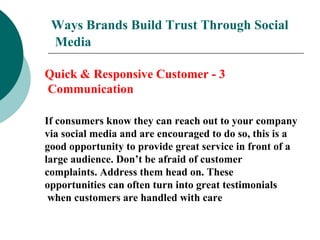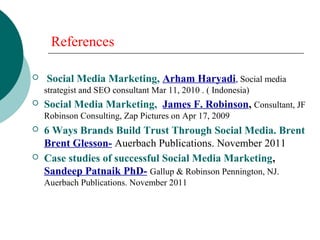Social media marketing ii
- 1. Social Media Marketing Ain Shams DBA – Group 6 Under Supervision Dr. Aisha El-Menway
- 2. Team Member 1. 2. 3. 4. 5. 6. 7. Khaled Nabil Kamal El-Attar Mohamed Abd El-Dayem Mohamed Abd El-Salam Mohamed Tohamy Shady Abd El-Salam Abd El-Naby Marzouk
- 3. Agenda 1. Introduction 2. Social Media Activity 3. Social Media Marketing Impact 4. Ways for Bulding Brands Trust 5. Case Study – Ford Fiesta 6. References
- 4. Introduction Abd El-Naby Marzouk What is the social media marketing “Social Media Marketing or SMM is the process of promoting a product, service or a brand using Social Media such as Facebook, LinkedIn, Blogs, Twitter, Flickr, YouTube etc.”
- 5. Introduction ?Why using SMM Face book has 500+ million users, 45 billion shared items per month, active local business 1.5 million pages Linked In has more than 40 million users and more than 12.4 million unique visitors per month) Twitter 156+ million register users, 31% users following a brand, brand recommendation 7.8 million per month
- 6. Introduction Benefits of social media marketing Control your Brand Get Link Love Show the Community You're a Participant Build Traffic from Alternate Sources Influence Traditional Media
- 7. Introduction Benefits of social media marketing Increasing the revenue: Dell made US$ 2 million using Twitter. Multiplying sales: MASI bicycles doubled sales in two years using bogging and pod casting to reach out. Building up the relevant community: American Express multiplied its user base 80 times in 11 months using Social Network. Online Reputation: A video on You Tube posted by 2 employees of Dominos coasted them over US$ 50m. .
- 8. Introduction Type of Social Media Marketing
- 9. Social Media Activity Mohamed Tohamy
- 10. Social Media Activity 1- Publish
- 11. Social Media Activity 2- Share
- 12. Social Media Activity 3- Network Anyone can connect to everyone Make friends Be helpful Sharing Interest
- 13. Social Media Impact Mohamed A. Salam Impact of social media on marketing As marketers are always interested to grab the attention of the consumer. People have embraced new media and technologies to such an extent like smart phone etc. has given marketers the opportunity to reach consumers in a 24/7 capacity through a variety of mediums. It enhances the chances of messaging being seen. Therefore it is obvious to allure the marketers towards social media. Traditional campaigning approaches are overshadowed not only by rising social media but also due to increasing difficulty to create an outstanding campaign due to very competitive market. The problem lies with the change in the consumer's mindset. Social media has led to a culture of active engagement, immediate access to anyone and for anything and constant communication. This is of course something that the traditional advertisement and other marketing methods could not ever achieve. Whereas social media like Face book page, Twitter and You Tube et
- 14. Social Media Impact Criticism of social media As the social media has grown in popularity, multiple concerns have emerged regarding technology. If comments and tweets are posted in haste, it can lead to some marketing disasters that can damage both the client and their agencies reputation. The moment consumer finds a brand's social networking activity intrusive or annoying then consumer is lost. There are many instances where brands try to abuse the system thorough fake comments. Since marketers are directly dealing with the public can not lurk behind the scene but have to become more accountable for the brand. Other concerns of social media are social media stalkers, child predators and privacy concerns In spite of potential drawbacks of social media, popularity of social media is overtaking traditional forms of marketing. If compare TV commercials with online virals promoted through social media, TV commercials can cost millions; are poorly targeted and do not enable data capture where as cost on social media is almost nothing. That is why social media become popular among marketers.
- 15. Ways for Building Brands Trust Through Social Media Khaled Nabil Using social media for business marketing has been a hot topic for years now, but brands are still trying to harness the power of the digital socialsphere to discover the best ways to directly impact their bottom lines. As social media use advances, so does the frequency in which brands are reaching out to their audiences to engage them through these channels. One tactic that might be lost in all of this is the importance of using social media channels to build trust with your current and potential brand advocates.
- 16. Ways Brands Build Trust Through Social Media 1- Communicating Thought Leadership One way for a brand to lose credibility with a social audience is to simply spam them with “opportunities” to purchase a product or service without providing any value, This value can come in many forms, but should be designed to teach, entertain, ignite discussions, and gain honest feedback. Social media is the perfect platform for a brand to communicate their expertise in a given industry, and do so by providing great content that people will share with others. This is how companies can become thought leaders in their space
- 17. Ways Brands Build Trust Through Social Media 2- Transparency This is an area that executives and decision makers have feared the most but a hurdle that must be overcome for a company to be successful using social media. In today’s digital world, transparency is an inherent reality, as people will be talking about issues associated with your brand online. Companies need to embrace this and get involved in guiding that conversation. In a report from eMarketer, 77% of buyers said they are more likely to buy from a company if the CEO uses social media, and 82% trust the company more. This is impressive, and telling of how consumers want to engage with brands and top-level executives.
- 18. Ways Brands Build Trust Through Social Media Quick & Responsive Customer - 3 Communication If consumers know they can reach out to your company via social media and are encouraged to do so, this is a good opportunity to provide great service in front of a large audience. Don’t be afraid of customer complaints. Address them head on. These opportunities can often turn into great testimonials when customers are handled with care
- 19. Ways Brands Build Trust Through Social Media 4- Ensures Accountability: When companies are openly engaged in social media and encouraging their audience to interact with them, it ensures a certain level of accountability. In using social media aggressively, a brand can essentially hold itself accountable for providing great products, services, and customer service. They can’t afford not to! But isn’t that the goal anyway?
- 20. Ways Brands Build Trust Through Social Media 5- Fun & Simple Engagement: Another way to build and maintain trust is through entertainment. Don’t always make it about your company and its services or value. This goes back to thought leadership and content marketing. Provide value in a fun and creative way through daily content, apps, videos, contests, sweepstakes, and infographics. The opportunities are endless.
- 21. Ways Brands Build Trust Through Social Media 6- Social Responsibility : A great way to build trust with your customers is to let them know that you care about others more than just yourself. The same goes for building brand equity. Socially responsible brands often gain more momentum because their customers know they aren’t just about profits, but also giving back to their communities or the world around them. Social media channels are the perfect platform to ommunicate this message and let it spread organically. For example, Marriott is running a check-in campaign that encourages guests to check-in, and the hotel will donate $2 to charity. This promotion is intended to leverage a typical social interaction for the greater good.
- 22. Case Study Mohamed A. Dayem Marketing in social media The rising interest in social networking sites as viable vehicles for marketing is also reflected in the money being spent to advertise in social networks. According to E-Marketer spending on advertisements on social networking sites has increased from $ 1.40 billion in 2009 to a projected $ 3 billion in 2011, a nearly 50% .increase4
- 23. Case Study Successful use of Social Media Considering the relatively short history of social networking sites, it is remarkable to find that a large number of organizations have already successfully used them as platforms to promote their brands, support customers and increase business. Some of the most successful Marketing campaigns have involved creative use of Face book and Twitter. Face book particularly has developed into a very hospitable platform for a wide array of marketing initiatives by diverse organizations
- 24. Case Study Ford Case Study One of the earliest and most successful social media campaign, called the Fiesta Movement, was launched by Ford in April 2009 to promote its Fiesta model. In an innovative strategy, the company selected 100 top bloggers and gave each of them a Fiesta to use for the next six months. In return they (i.e., the bloggers or ‘agents’) were required to upload a video on You Tube about the car along with an independent account of their experience with the Fiesta, on their blogs
- 25. Case Study The Fiesta Movement campaign success •The 700+ videos created by the “agents” generated •6.5 million viewers - You Tube •Created more than 3.4 million impressions - Twitter. •Photos of the car uploaded were viewed more than 670,000 times - Flicker •The campaign generated considerable buzz about the vehicle with more than 50,000 US they wanting more information about the Ford Fiesta. •Ford sold 10,000 units in the first six days of sales
- 26. References Social Media Marketing, Arham Haryadi, Social media strategist and SEO consultant Mar 11, 2010 . ( Indonesia) Social Media Marketing, James F. Robinson, Consultant, JF Robinson Consulting, Zap Pictures on Apr 17, 2009 6 Ways Brands Build Trust Through Social Media. Brent Brent Glesson- Auerbach Publications. November 2011 Case studies of successful Social Media Marketing, Sandeep Patnaik PhD- Gallup & Robinson Pennington, NJ. Auerbach Publications. November 2011
- 27. Thank you



























